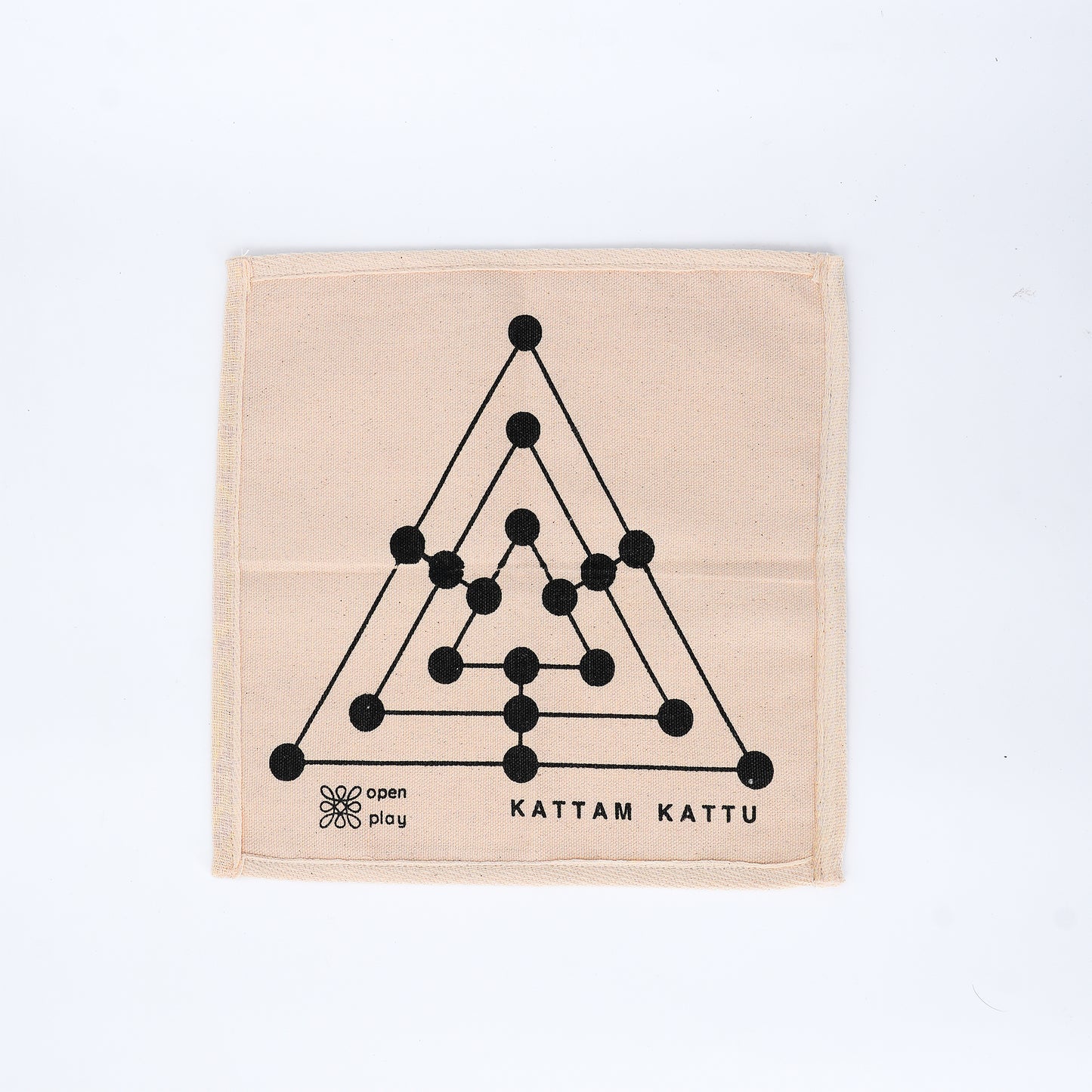Open Play
Kattam Kattu + Kattam Vilayatu
Kattam Kattu + Kattam Vilayatu
Couldn't load pickup availability
Shipping and Packaging
Shipping and Packaging
- Weight: 150gm
- Dimensions: pouch 6 x 6 inches | Mat 8.5 x 8.5 inches
- Contents: 1 pouch consisting of a game printed on the back, 1 game mat, tokens, a game rule card with a QR code
- Shipping Timeframe: 5-7 business days
- Shipping Cost: included in MRP
- International Shipping: No
The packet weighs 150 grams, and the product price includes shipping and handling. The estimated shipping time is 5–7 days business days.
Kattam Kattu
Kattam Kattu is a strategy board game that belongs to the "mills" family of games, where players form rows of three tokens (a "mill") to capture opponents' tokens. Variants of this game exist worldwide, including Rota from ancient Rome and Asha from Africa. The game is known for its diverse board designs, which range from simple three-token setups to complex twelve-token arrangements.
Contents
1 game board
6 tokens per player
Objective
The goal is to form "mills" (a row of three tokens) to capture (remove) the opponent’s tokens. A player loses when they are reduced to two tokens or their tokens are completely blocked.
How to Play
I. Placing Tokens
a. The board starts empty.
b. Players take turns placing one token at a time on an intersection or corner of the board.
c. If a player forms a mill (three tokens in a row), they capture (remove) an opponent’s token.
d. Captured tokens are permanently removed.
II. Moving Tokens
a. Once all tokens are placed, players take turns moving their tokens.
b. A token can move along the lines to an adjacent intersection.
c. Players aim to form new mills to continue capturing opponent tokens.
Capturing Rules
I. Capturing is mandatory if a player forms a mill. The player may remove any opponent’s token, except those already in a mill. If all the opponents tokens are in mills, then the player may remove any token.
III. Players can build and break the same mill repeatedly, capturing an opponent’s token each time.
IV. If a player forms two mills in a single move, they capture (remove) two tokens.
Winning the Game
A player loses if:
I. They are left with only two tokens, making mills impossible.
II. All their remaining tokens are blocked and cannot move.
Board Variations
Kattam Kattu has many board designs, affecting variations in gameplay:
I. Basic Mills: 3- or 4-token games (like Asha) end immediately when a mill is formed.
II. Roman Rota (Tabula Lusoria): Found carved in ancient Roman ruins, featuring a circular design.
III. Two-square Mills (5–7 tokens): Two nested squares with limited mill formations on connecting lines.
IV. Sixpenny Maddell (England): A triangular board allowing mills along connecting lines.
V. Large Mills (9–12 tokens): Three nested squares with multiple connecting lines.
VI. Modern Variants:
a. "Web" and "Grid" boards include diagonals for more mill combinations.
b. "Snail" and pentagonal boards (12 tokens).
c. Hexagonal boards (13 tokens).
Players can create their own boards, experimenting with different layouts for fresh challenges.
- - - - - - - - - - - - - - - - - - - - - - - - - - - - - - - - - - - - - - -
Kattam Vilayatu
Kattam Vilayatu is a traditional strategy game where players aim to align their pieces in a straight line on a 3×3 grid.
Contents
One1 3x3 board with 9 intersections
Each player has three pieces (tokens) of different colors.
How to Play
I. Placement Phase
a. Players take turns placing one piece at a time on any empty intersection.
b. The goal is to position pieces strategically to form a mill or block the opponent.
II. Movement Phase (after all pieces are placed)
a. Players take turns moving one piece to an adjacent empty intersection along the grid lines.
b. The aim is to form a mill while preventing the opponent from doing the same.
III. Winning Condition
The first player to align three pieces in a straight line wins the game.
Important Rules & Considerations
I. Only one piece can occupy an intersection at a time.
II. Pieces cannot jump over other pieces.
III. If neither player forms a mill during placement, the game moves to the movement phase.
Share












